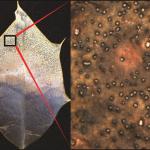Phyllosticta Leaf Blotch
Phyllosticta leaf blotch is caused by several Phyllosticta species.
Hosts
The most common hosts of Phyllosticta leaf blotch on deciduous shrubs and broad-leaved evergreens in southern New England include witchhazel (Hamamaelis), holly/inkberry (Ilex), hydrangea (Hydrangea), rhododendron/azalea (Rhododendron) and mountain laurel (Kalmia).
Symptoms & Disease Cycle
Phyllosticta species are opportunistic pathogens that cause leaf spots, blotches, marginal leaf blight, and a total collapse of infected foliage. When severe, there can significant foliar dieback and premature leaf shedding. In most landscape settings, Phyllosticta is not an aggressive pathogen, but the pathogen is common and damage varies by year and region. Phyllosticta most often occurs in conjunction with winter injury on evergreens like inkberry, holly, rhododendron and mountain laurel, readily colonizing and spreading on injured foliage. On deciduous shrubs like witch-hazel and hydrangea, high levels of shade, moisture and humidity often drive disease outbreaks. The fungus produces tiny, black-colored fruiting bodies (pycnidia) within the necrotic tissue and spores are readily disseminated to healthy foliage during wet weather. Typically, these fruiting bodies are too small to be observed in the field.
Phyllosticta hamamelidis is specific to witch-hazel and is very common in Massachusetts. Like all true Phyllosticta species, P. hamamelidis produces small, circular leaf spots that can coalesce to produce large necrotic blotches on infected leaves. Infected leaves often harbor numerous blotches and when shade and moisture are abundant in May and June, there can be significant lower and interior canopy leaf shedding, reducing growth and reducing aesthetics. Phyllosticta leaf blotch of witch-hazel does not seem to impact the long-term health of infected shrubs, despite the significant leaf loss during certain years.
Management
Phyllosticta leaf blotch can be difficult to manage in landscape settings but a great deal depends on the host and weather conditions. The pathogen overwinters on infected foliage in the canopy and discarded foliage around the plant. During mild and wet weather in spring and early summer, Phyllosticta can readily sporulate and new infections are initiated. On evergreens like rhododendron and holly, prune out foliage damaged by winter injury by early spring to reduce opportunistic colonization. On deciduous hosts like hydrangea and witchhazel, prune out badly infected leaves from the canopy and remove all prematurely shed foliage during the early growing season. Pruning to improve air flow and reduce the volume of foliage in deep shade within the interior canopy can also help to reduce disease severity. Even at its worst, the disease should not be considered a major threat to the overall health of infected trees and shrubs. However, in conjunction with other stresses, such as drought, insect infestation, mechanical injuries (i.e. mowers and string trimmers), poor/compacted soils, etc, the disease can be an important component of decline. Chemical management is often not warranted, but the following fungicides may have some utility against Phyllosticta when applied early in the season as new laves are developing: copper salts of fatty and/or rosin acids, copper hydroxide, mancozeb, metconazole and propiconazole. Avoid fungicide application during periods of bloom when pollinating insects may have contact.


